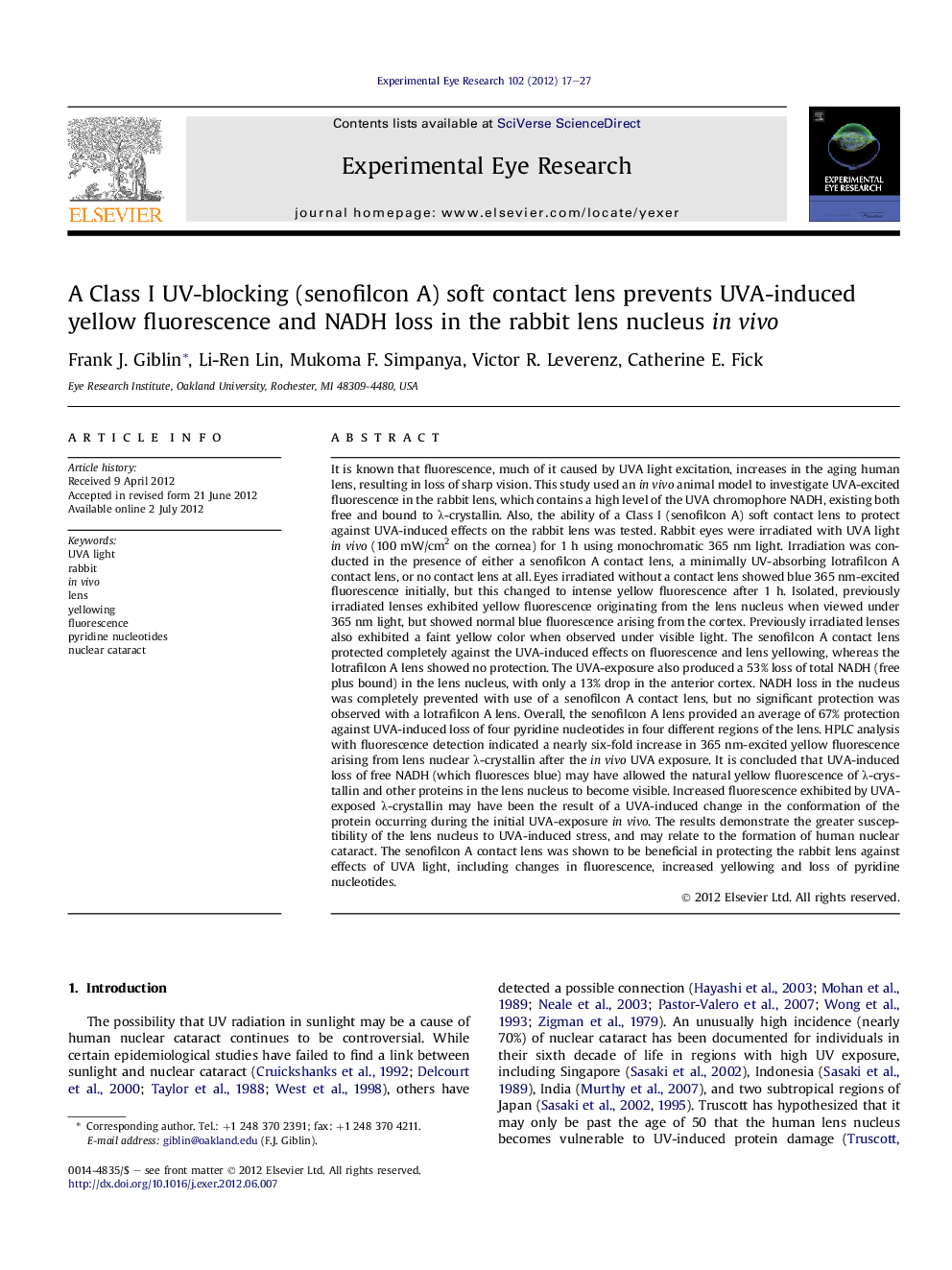| کد مقاله | کد نشریه | سال انتشار | مقاله انگلیسی | نسخه تمام متن |
|---|---|---|---|---|
| 4011297 | 1602620 | 2012 | 11 صفحه PDF | دانلود رایگان |

It is known that fluorescence, much of it caused by UVA light excitation, increases in the aging human lens, resulting in loss of sharp vision. This study used an in vivo animal model to investigate UVA-excited fluorescence in the rabbit lens, which contains a high level of the UVA chromophore NADH, existing both free and bound to λ-crystallin. Also, the ability of a Class I (senofilcon A) soft contact lens to protect against UVA-induced effects on the rabbit lens was tested. Rabbit eyes were irradiated with UVA light in vivo (100 mW/cm2 on the cornea) for 1 h using monochromatic 365 nm light. Irradiation was conducted in the presence of either a senofilcon A contact lens, a minimally UV-absorbing lotrafilcon A contact lens, or no contact lens at all. Eyes irradiated without a contact lens showed blue 365 nm-excited fluorescence initially, but this changed to intense yellow fluorescence after 1 h. Isolated, previously irradiated lenses exhibited yellow fluorescence originating from the lens nucleus when viewed under 365 nm light, but showed normal blue fluorescence arising from the cortex. Previously irradiated lenses also exhibited a faint yellow color when observed under visible light. The senofilcon A contact lens protected completely against the UVA-induced effects on fluorescence and lens yellowing, whereas the lotrafilcon A lens showed no protection. The UVA-exposure also produced a 53% loss of total NADH (free plus bound) in the lens nucleus, with only a 13% drop in the anterior cortex. NADH loss in the nucleus was completely prevented with use of a senofilcon A contact lens, but no significant protection was observed with a lotrafilcon A lens. Overall, the senofilcon A lens provided an average of 67% protection against UVA-induced loss of four pyridine nucleotides in four different regions of the lens. HPLC analysis with fluorescence detection indicated a nearly six-fold increase in 365 nm-excited yellow fluorescence arising from lens nuclear λ-crystallin after the in vivo UVA exposure. It is concluded that UVA-induced loss of free NADH (which fluoresces blue) may have allowed the natural yellow fluorescence of λ-crystallin and other proteins in the lens nucleus to become visible. Increased fluorescence exhibited by UVA-exposed λ-crystallin may have been the result of a UVA-induced change in the conformation of the protein occurring during the initial UVA-exposure in vivo. The results demonstrate the greater susceptibility of the lens nucleus to UVA-induced stress, and may relate to the formation of human nuclear cataract. The senofilcon A contact lens was shown to be beneficial in protecting the rabbit lens against effects of UVA light, including changes in fluorescence, increased yellowing and loss of pyridine nucleotides.
Figure optionsDownload high-quality image (229 K)Download as PowerPoint slideHighlights
► Rabbit eyes were irradiated with 365 nm light (100 mW/cm2) in vivo for 1 h
► Isolated lenses under 365 nm light showed yellow fluorescence from the nucleus.
► UVA-exposed lens λ-crystallin showed 6-fold higher yellow fluorescence than control.
► The UVA caused 53% loss of NADH in the lens nucleus and 13% in the cortex.
► A senofilcon A contact lens prevented UVA effects on lens fluorescence and NADH.
Journal: Experimental Eye Research - Volume 102, September 2012, Pages 17–27